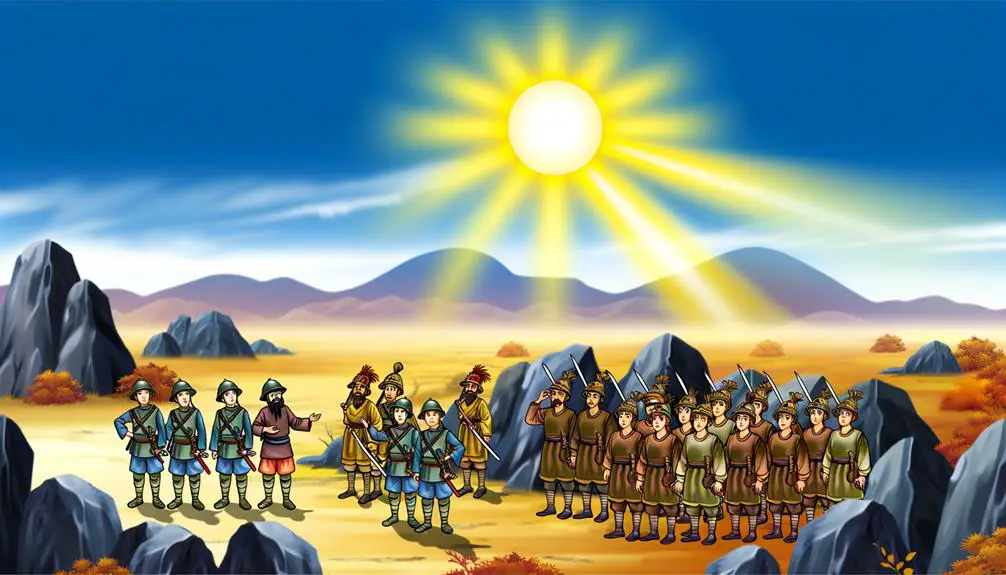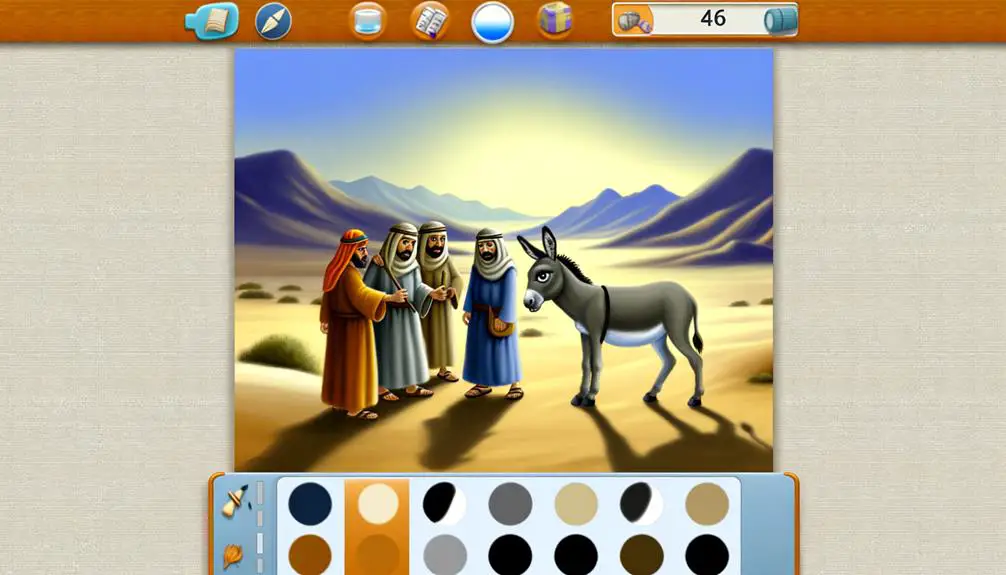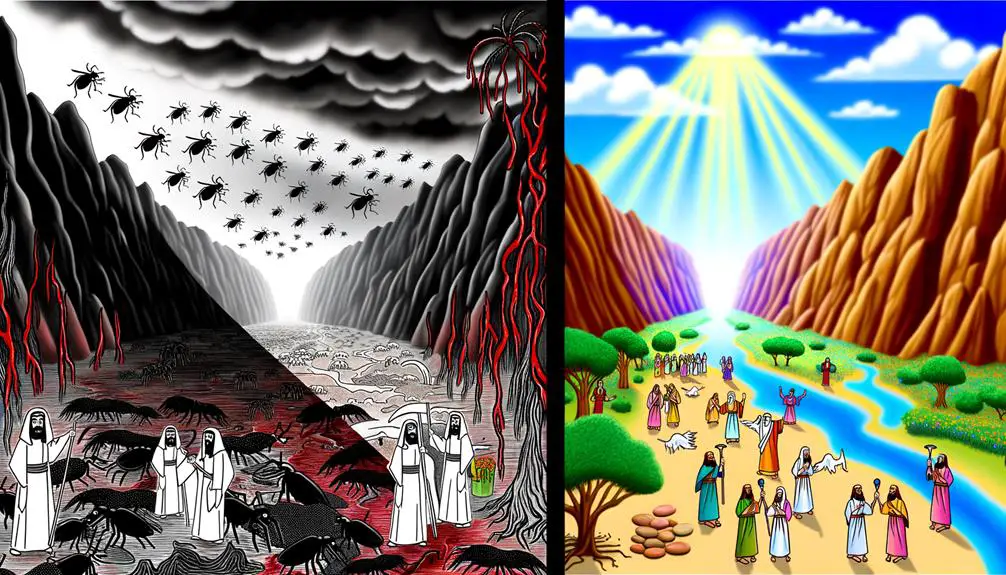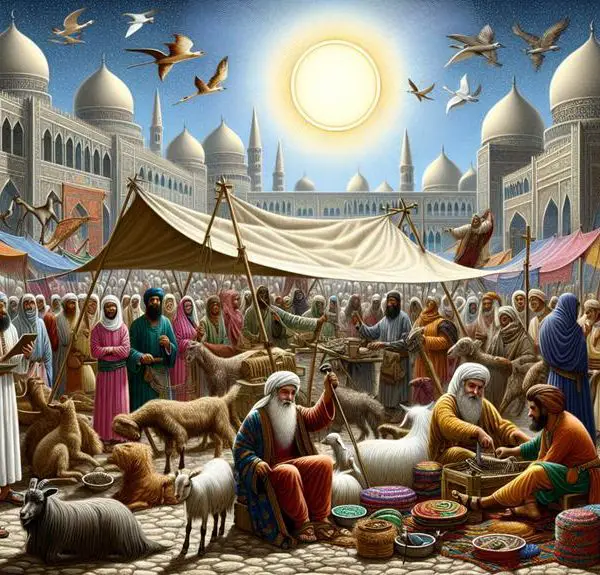Uncover the unexpected tales of unicorns, dragons, and talking donkeys hidden within the pages of the Bible, where myth meets sacred text.

That's in the Bible
You might not realize it, but the Bible isn't just a collection of religious teachings; it's also a book filled with tales that could rival any modern fantasy novel. Among its pages, you'll find stories of unicorns and dragons, accounts of the sun standing still, and even a narrative involving a talking donkey.
While these elements might make you think you've stumbled into a world of myth and legend, they're actually woven into the fabric of one of the world's most revered texts. Let's explore these unexpected facets together, and you might discover a side of the Bible you never knew existed.
Key Takeaways
- The Bible features mythical creatures like unicorns and dragons, symbolizing various moral and spiritual lessons.
- Biblical accounts, such as the sun standing still, blend historical context with divine intervention, challenging traditional scientific interpretations.
- Narratives like the talking donkey and divine punishments emphasize the importance of communication and respect for divine authority.
- Themes of love, seduction, and ethical dilemmas, as seen in the Song of Solomon and the Witch of Endor, reflect on deeper moral teachings.
Unicorns and Dragons

Despite common misconceptions, references to unicorns and dragons in the Bible have sparked considerable debate among scholars, revealing a complex interplay between ancient texts and modern interpretations. You might find yourself questioning how these mythical creatures fit within the sacred scripture and what they symbolize. The discussion isn't just about identifying myth within a religious context but delves deeper into cultural interpretations and the evolution of language over centuries.
When you explore the references to unicorns in the Bible, it's crucial to understand that these mentions are rooted in mythical symbolism rather than literal belief in such creatures. Scholars argue that the unicorn mentioned in the Bible could be a result of mistranslations or symbolize strength, purity, or a high status within ancient societies. This interpretation allows you to perceive how cultural contexts influence the reading and understanding of biblical texts.
Similarly, dragons in the Bible are often tied to chaos, evil, or destruction, serving as metaphors for greater spiritual battles or societal downfall. This symbolic use of dragons showcases the Bible's use of allegory to convey moral and ethical lessons. Through this lens, you're encouraged to see beyond the literal and appreciate the rich tapestry of meanings that biblical authors weaved into their narratives.
Understanding these mythical references requires you to navigate through various cultural interpretations and scholarly debates. It's a testament to the Bible's multifaceted nature, inviting you to look deeper into its verses and appreciate the layers of meaning that have captivated scholars and believers alike.
The Sun Stands Still

You'll find the narrative of the sun standing still in the Bible both fascinating and complex, requiring a deep understanding of its historical context.
Scientific perspectives provide a unique lens through which to examine this event, challenging traditional interpretations while enriching our comprehension.
Lastly, unveiling its theological implications invites you to explore the profound messages and beliefs encapsulated within this extraordinary account.
Historical Context Explained
One of the most debated events in biblical scholarship, the account of the sun standing still, requires an in-depth exploration of its historical context to fully appreciate its implications. Understanding this phenomenon isn't just about the event itself but also about the broader context in which it occurred, including:
- Ancient diets: These played a crucial role in the stamina and capabilities of peoples involved, influencing the outcome of prolonged battles.
- Warfare strategies: The tactics employed by the Israelites and their enemies were deeply influenced by the terrain, the climate, and the perceived divine intervention.
- Cultural significance: This event held profound religious and moral implications for the societies involved, shaping their understanding of divine favor and intervention.
Scientific Perspectives Examined
Exploring the scientific perspectives on the biblical account of the sun standing still reveals a complex intersection of astronomy, physics, and historical interpretation. From an astronomical viewpoint, such an event challenges our understanding of cosmic creation and the fundamental laws governing celestial bodies.
Physicists argue that halting the earth's rotation abruptly would result in catastrophic consequences, not supported by geological or historical evidence. This narrative also intersects with discussions on genetic diversity, as some interpret it metaphorically, suggesting a divine intervention that transcends our understanding of time and space, rather than a literal pause in the Earth's motion.
This analysis underscores the necessity of integrating scientific inquiry with historical texts, encouraging a nuanced interpretation that respects both the physical laws of the universe and the symbolic language of ancient scriptures.
Theological Implications Unveiled
Delving into the theological implications of the biblical account where the sun stands still, we uncover layers of meaning that speak to divine intervention and human perception of God's power within the historical and scriptural context. This narrative isn't just a miraculous event; it's a rich tapestry woven with themes of divine justice and covenant relationships.
- Divine Justice: The event underscores God's willingness to enact miraculous interventions to uphold moral and divine order, emphasizing His role as the ultimate arbiter of justice.
- Covenant Relationships: It illustrates the depth of God's commitment to His covenant with Israel, showcasing that divine promises are backed by divine action.
- Human Perception of God's Power: This account challenges believers to expand their understanding of God's omnipotence and willingness to engage directly in the human realm for the sake of righteousness and faith.
A Talking Donkey

Within the pages of the Bible, there exists a unique narrative involving a talking donkey, an event that prompts intriguing theological and literary analysis. This story, found in the Book of Numbers, captures the moment when a donkey communicates verbally with Balaam, its owner. The narrative not only highlights the miraculous but also opens a window into understanding divine intervention and communication in biblical texts.
From the donkey's perspective, this event underscores the theme of unrecognized divine presence and intervention. The donkey sees an angel of the Lord blocking their path, which Balaam is oblivious to. This aspect of the story suggests a divine insight granted to the least expected character, challenging the reader's expectations about communication with the divine.
Cultural interpretations of this narrative vary significantly. In some traditions, the talking donkey is seen as a symbol of humility and a reminder that God's messages can come through any medium, emphasizing the importance of being open to divine guidance in all forms. In contrast, other interpretations focus on the comedic or absurd elements of the story, using it to illustrate the unpredictability of divine will.
Aspect |
Analysis |
|---|---|
Donkey's Role |
A medium for divine intervention, challenging norms. |
Cultural Impact |
Varied interpretations from reverence to humor. |
Theological Significance |
Raises questions about communication with the divine and the nature of miracles. |
In scrutinizing this narrative, it's clear that the talking donkey serves as a pivotal moment that bridges the human and divine, urging a deeper reflection on the ways in which we perceive and interpret the presence and messages of the divine in our lives.
Prophets and Bears

Another intriguing narrative found in the Bible involves two she-bears and the prophet Elisha, a story that raises profound questions about divine justice, authority, and the consequences of disrespect. This incident, while startling, encapsulates significant themes of bear symbolism and prophet significance, offering a rich tapestry for analytical exploration.
- Bear Symbolism: In biblical times, bears were seen as symbols of strength and ferocity. When the two she-bears emerge to maul the youths mocking Elisha, this act can be interpreted as a divine manifestation of punishment and protection. The bears' intervention underscores the seriousness with which disrespect towards God's prophets was viewed, emphasizing the societal expectation for reverence towards spiritual authority.
- Prophet Significance: Elisha, as a prophet, held a crucial role as God's mouthpiece to the Israelites. The mocking of Elisha by the youths not only represents a personal affront but a broader societal disrespect towards divine authority. This narrative illustrates the gravity of undermining prophetic messages and the consequences of such actions, reinforcing the status of prophets as sacrosanct figures within the biblical narrative.
- Divine Justice and Authority: The swift and severe punishment meted out to the mockers through the intervention of the bears serves as a stark reminder of the weight of divine justice. It underscores the belief in a God who actively enforces the respect of His commands and messengers, highlighting the omnipotent authority that governs moral and spiritual order.
In analyzing this narrative, it's clear that the story of the prophets and bears isn't merely about retribution but serves as a complex allegory for understanding divine justice, the sanctity of prophetic roles, and the societal imperatives of respect and reverence.
Love Poetry and Seduction

Shifting focus from the stark narratives of divine justice and prophetic authority, we now explore the nuanced expressions of love and desire as articulated through biblical love poetry and seduction themes. The Bible, often perceived as a collection of laws, histories, and prophecies, also contains a treasure trove of poetic literature that delves into human emotions and relationships. A quintessential example is the Song of Solomon, a book that stands out for its unabashed celebration of romantic love and physical attraction between a bride and groom.
The Song of Solomon uses a plethora of romantic metaphors to convey the beauty and intensity of love. You'll find imagery drawn from nature, such as flowers, gardens, and springs, which serve not only to embellish the narrative but also to symbolize the flourishing of love and desire. This poetic technique enriches the text, offering a multi-layered understanding of love that transcends the literal.
Moreover, the Song of Solomon challenges traditional views by presenting a dialogue between lovers, with the female voice being especially prominent. This aspect of mutual desire and admiration provides a counter-narrative to the more patriarchal themes prevalent in other biblical texts. It's a reminder that the Bible encompasses a diverse range of voices and perspectives, including those that celebrate mutual, consensual love.
In analyzing these themes, it's crucial to appreciate the historical and cultural context in which these texts were written. The romantic metaphors and expressions of desire found in the Song of Solomon reflect not only the human experience of love but also the artistic and literary conventions of the time.
The Witch of Endor

You'll encounter a significant departure from the themes of love and poetry as we delve into the narrative of the Witch of Endor, a story that intertwines the supernatural with the profound consequences of seeking forbidden knowledge. This tale, steeped in the rich tapestry of biblical history, presents an intriguing exploration of Saul's desperation and the controversial ethics of necromancy.
The story unfolds as Saul, facing imminent defeat and feeling abandoned by God, seeks the Witch of Endor's powers to summon the spirit of the deceased prophet, Samuel. This act, driven by Saul's desperation, highlights three critical aspects:
- Saul's Forbidden Quest: Contrary to divine law, Saul's pursuit of necromantic practices underscores his profound despair and isolation, marking a pivotal moment of ethical and moral transgression.
- The Witch's Power: The narrative presents a rare biblical acknowledgment of supernatural abilities outside the domain of the divine, challenging traditional perceptions of power and knowledge.
- The Ethics of Necromancy: Engaging in necromancy, the story provokes a deep analysis of the ethical boundaries crossed in seeking knowledge and guidance from beyond the grave. It raises questions about the moral implications of such actions and their consequences.
In this detailed examination, the story of the Witch of Endor serves as a cautionary tale about the dangers of succumbing to despair and resorting to forbidden means in search of answers. It prompts a scholarly reflection on the ethical considerations of engaging with the supernatural, against the backdrop of Saul's desperation. This biblical episode encourages a thoughtful exploration of the complex interplay between faith, morality, and the pursuit of knowledge beyond our reach.
Plagues and Miracles

From the supernatural encounters at Endor, we turn our attention to the remarkable events of plagues and miracles, pivotal moments that showcase divine intervention in human affairs. These narratives, rich in symbolic and theological significance, are central to understanding the nature of divine power and its interaction with humanity. At the heart of these stories is Moses, a figure whose life intertwines with miracles that define a nation's destiny.
Moses' staff, more than a mere shepherd's tool, becomes an instrument of divine will. Its transformations and the miracles it induces are emblematic of a deeper spiritual authority. When Moses confronts Pharaoh, his staff transforms into a serpent, a sign of divine power that challenges the Egyptian magicians' sorcery. This moment marks the beginning of a series of plagues, each a manifestation of divine judgment against the Egyptian gods, culminating in the liberation of the Israelites.
The parting of the Red Sea is perhaps the most dramatic of these miracles, a testament to divine providence and protection. With a wave of Moses' staff, the waters recede, allowing the Israelites safe passage, only to converge upon their pursuers. This event isn't merely a historical or mythological account but a theological declaration of divine fidelity and omnipotence.
These narratives of plagues and miracles serve a dual purpose: they affirm the sovereignty of the divine and offer insight into the nature of faith, obedience, and deliverance. They remind us that within the pages of sacred texts lie profound truths about the divine-human relationship, encapsulated in moments of extraordinary intervention.
Frequently Asked Questions
How Does the Bible Address Modern Ethical Dilemmas Such as Genetic Engineering and Artificial Intelligence?
You might wonder how ancient texts address modern ethical dilemmas like genetic engineering and artificial intelligence.
The Bible doesn't mention these technologies directly, but it sets ethical boundaries rooted in understanding the Creator's intent.
What Does the Bible Say About the Existence of Extraterrestrial Life?
You're exploring if extraterrestrial life is mentioned in the Bible, focusing on angelic beings and cosmic creation. While it doesn't explicitly discuss aliens, it does mention celestial beings and the vastness of creation, suggesting a universe filled with wonders beyond our understanding.
Analyzing texts, one might infer that the existence of other life forms isn't ruled out, considering the detailed depiction of angelic entities and the emphasis on a meticulously crafted cosmos.
How Are Concepts of Mental Health and Psychological Disorders Treated in Biblical Texts?
You're diving into how mental health and psychological disorders are framed, quite the mind-bender. The texts don't directly diagnose as modern psychology would but approach healing and disturbances through spiritual healing and divine intervention narratives.
Analyzing these passages, it's clear that well-being is often linked with spiritual health, suggesting that divine intervention was seen as a crucial element in what we'd now consider mental health care. This perspective intertwines faith with psychological wellness, a nuanced view.
Can the Bible Provide Guidance on Navigating the Challenges of Digital and Social Media Use?
When you're navigating digital and social media challenges, it's crucial to seek wisdom and practice digital temperance.
While specific references to modern technology aren't found, the principles of moderation, self-control, and discernment are deeply embedded.
Analyzing these texts, you can extract valuable insights on managing your digital footprint responsibly.
It encourages a balanced approach, ensuring you're not consumed by online distractions but use these tools to enhance your life and connections.
How Does the Bible Approach the Topic of Environmental Conservation and Climate Change?
You'll find the Bible doesn't explicitly address 'environmental conservation' or 'climate change' by those terms. However, it embodies the ethos of Creation care through stewardship principles.
It advocates for respecting and preserving the environment as God's creation, urging humans to act as stewards rather than exploiters. This approach implies a duty to protect natural resources, aligning with modern environmental conservation efforts and the fight against climate change in a broader, more timeless context.
Conclusion
In exploring the tapestry of narratives woven into the Bible, you've navigated through lands where unicorns roam and dragons take flight, paused under a sun frozen in the sky, and listened to a donkey's counsel.
It's akin to standing before the Tree of Knowledge, each story a fruit ripe with metaphors, inviting deep contemplation. Like seeds, these tales plant themselves within us, sprouting insights into our collective psyche.
Thus, the Bible remains not just a book, but a living garden of human understanding.



Sign up